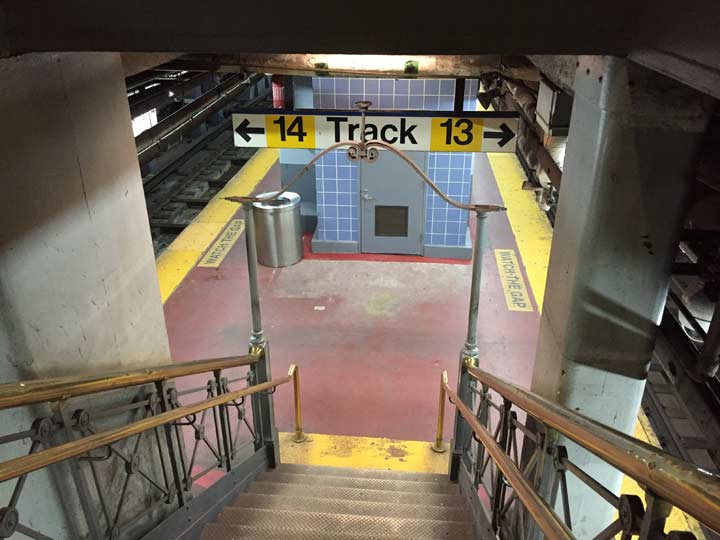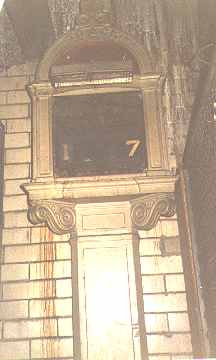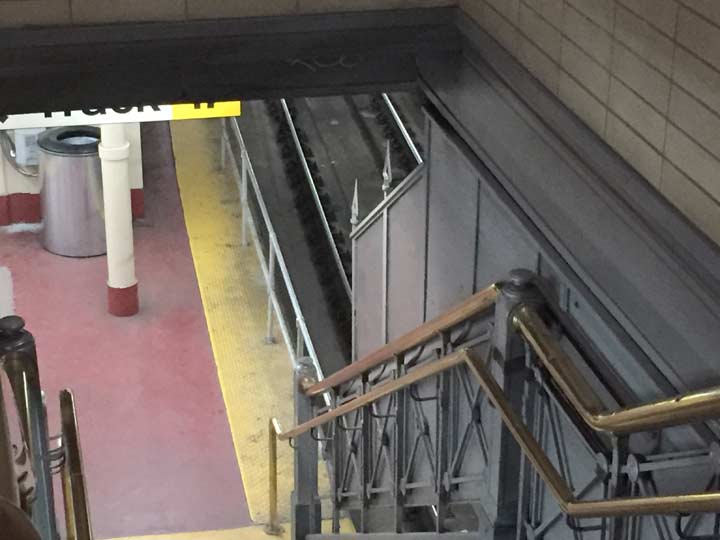
 The old Penn Station is not completely gone. If you poke around long enough in the basement of Madison Square Garden, which is what the ‘new’ Penn Station became, you can find a hint or two of the old magnificent Penn still there. And you can even find a couple of hints in broad daylight, too. I chronicled some of these in a FNY page way back in 1999.
The old Penn Station is not completely gone. If you poke around long enough in the basement of Madison Square Garden, which is what the ‘new’ Penn Station became, you can find a hint or two of the old magnificent Penn still there. And you can even find a couple of hints in broad daylight, too. I chronicled some of these in a FNY page way back in 1999.
Possibly the most intriguing find is the discovery of part of an original track indicator in the baggage area near Track 1 (left). The ornate indicators were a hallmark of the old Penn, standing 16 feet high and complementing the ornate fencing and bannisters. The aluminum sign cards were painted bright red. The track number appeared in the semicircular area on top. The two numbers on the bottom were used to show the departure time. However, the indicator isn’t in an area frequented by the public, and you need to request to see it when on a Penn Station tour. One such tour I was on, led by Lorraine Diehl, author of The Late, Great Pennsylvania Station (Four Walls Eight Windows 1996) inspired me to write the original page.
At the top, on one of the staircases going to Tracks 13 and 14 you see one of the original Penn Station brass subway railings installed in 1910. And, unique in the station, at the bottom of the steps is a bracket that likely once held an electric lamp.

Meanwhile on Track 17, a set of steps has the brass railings and also a decorative element, a set of spikes on the side wall. Track 17 is unique in Penn Station as it does not share a platform with another track, and the platform is narrower than the others; the Track 18-19 platform, meanwhile, is much wider than the others. I do not know the reason for this discrepancy, so if anyone does, fill me in in Comments!
Most of the brass rails have been removed in previous decades, as new stairwells and escalators have been installed.
3/23/18

6 comments
I think that FDR and other VIPs came in on the unconnected single track for security reasons.
That was Grand Central Terminal
Re: the difference in platform widths, tracks 17-19 were the original LIRR trackage, with 18-19 as the centerpiece platform for service going out east. You must remember that when the original Penn Station was built, Long Island was still largely rural and ridership was nowhere near what it is today, thus the need for only a few platforms.
If memory serves; the book “Steel Rails to the Sunrise” (history of the LIRR) has a good section with photos of the old Penn Station. I gave the book to my cousin years ago and haven’t seen it since.
Coming up from track 18 I’d grip those brass handrails wishing somehow the old Penn Station would be there when I reached the top.
When Penn Station opened, its major traffic sources were expected to be the Pennsylvania RR services to and from New Jersey and points south (today’s Northeast Corridor trains of both Amtrak and NJ Transit). The Long Island RR was not expected to be generate the traffic it handles today. So Tracks 20 and 21 were designed for arriving LIRR trains, and 18 and 19 were designed to be the primary departure tracks for LIRR trains, thus the reason for the unusually wide layout. Track 17’s purpose was to provide LIRR with an additional departure track. Tracks 1 through 16 were initially reserved for PRR trains. By the 1950s LIRR provided about three-quarters of the train movements in and out of Penn, and thus required use of Tracks 13-21.